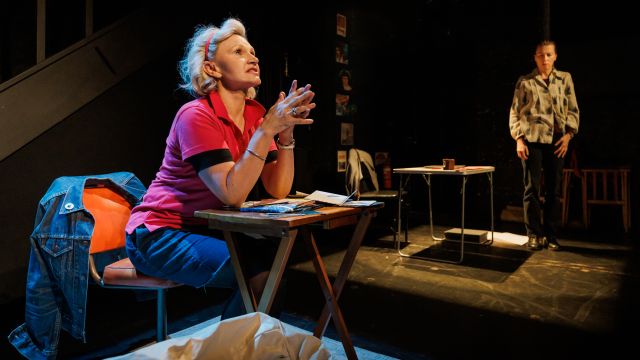She Wrote the Letter
Two pen friends write to each other, beginning as teenagers and ending as mature women. They exchange news of the trials of growing up, of falling in love, of their good and bad choices, pop music, careers, boyfriends, marriage, children, hopes, dreams, and their yearning to meet face-to-face. Kieran Carroll’s play is based on the real letters New Zealander Tania McNaughton wrote to her friend Ute Dahlke in the DDR, and the letters Ute wrote to her. The real Tania and Ute, the program tells us, have now been friends for forty-three years.
For one, life was sunny and free with easy choices and options. For the other, harsh conditions, restrictions, and the dangers of life in a totalitarian country. Ute (Maria Nordenberg – a performance of real charm and presence) is in a small town in East Germany. She is uncertain of her English and frequently speaks German – at least at first. When the two agree to be pen friends, Tania (played by the real Tania McNaughton) lives in NZ. Neither really knows, let alone understands, the other’s situation. Naturally, both learn. Ute is inevitably the more interesting character because she lives, with no escape, in more fraught circumstances.

Ute writes of rigid educational conditions in East Germany. A chilling line delivered in a matter-of-fact way by Ute about when she finishes high school: ‘… and then I hope to qualify as a skilled worker.’ As if that’s what the State has decreed and it’s the best she can possibly hope for. She is amazed by and envious of Tania’s freedom of choice. At the same time Ute must be careful: are the Stasi (Security Police) opening their letters? The letters certainly take a long time to arrive… But the years pass. They share a love of the same pop group. They grow up. Backpacker Tania makes it to – or into – East Germany, but things go awry. The chances of Ute coming to Auckland are nil. Children are born. The Wall comes down. Modes of communication change: from handwritten letters to crackling phone calls (and who’s listening in?) to email, to Skype…
Director Cathy Hunt (also the dramaturg) employs a simple setting: Ute stage left, Tania stage right, with minimal but appropriate furniture. (Design and wardrobe are by Grace Mallinson.) But experienced playwright Kieran Carroll and Cathy Hunt make some curious choices. Rather than making a judicious selection of fewer representative events and transitions (as is usually the case with dramatizing biography), giving us those in greater depth, and taking us closer to the women’s personalities and feelings, the play – close to ninety minutes – opts to ‘cover’ the whole of the time span of the women’s correspondence. We go from teens through to mature women. As a result, the play becomes almost a list - more about the means of communication than about what is communicated.

After a promising beginning, where we are drawn in by the stark differences of personality, language and situation, by the adventure of having a pen friend in a faraway place, the exchanges we get as the play progresses reduce almost to ticking off events, one thing after another, without much substance. While there is a lovely line about how the first handwritten letters have been kept, and thus are permanent, so the friends can go back and read them over and over, we get a catalogue of events and feelings that become a series of set-ups without pay-offs. Children get sick but we don’t find out what happened; we assume they were all right. Ute becomes more than a ‘skilled worker’. And? Both women find husbands, but there are scant details about these fellows. Ute is worried about Stasi surveillance. Is she right to be? Eventually, years after the Wall comes down, she gets her Stasi file – and there are copies of some of Tania’s letters. How did Tania feel about that? We never know.
Essentially, this is a play about an enduring friendship, sustained over many years without flesh and blood presence. But here, we might even begin to wonder why these two were and are friends. The exchanges between them that we get are not particularly intimate or revealing and they often are, unfortunately, banal. That may be true and real, but this is theatre, isn’t it?
Michael Brindley
Photographer: Darren Gill
Subscribe to our E-Newsletter, buy our latest print edition or find a Performing Arts book at Book Nook.

